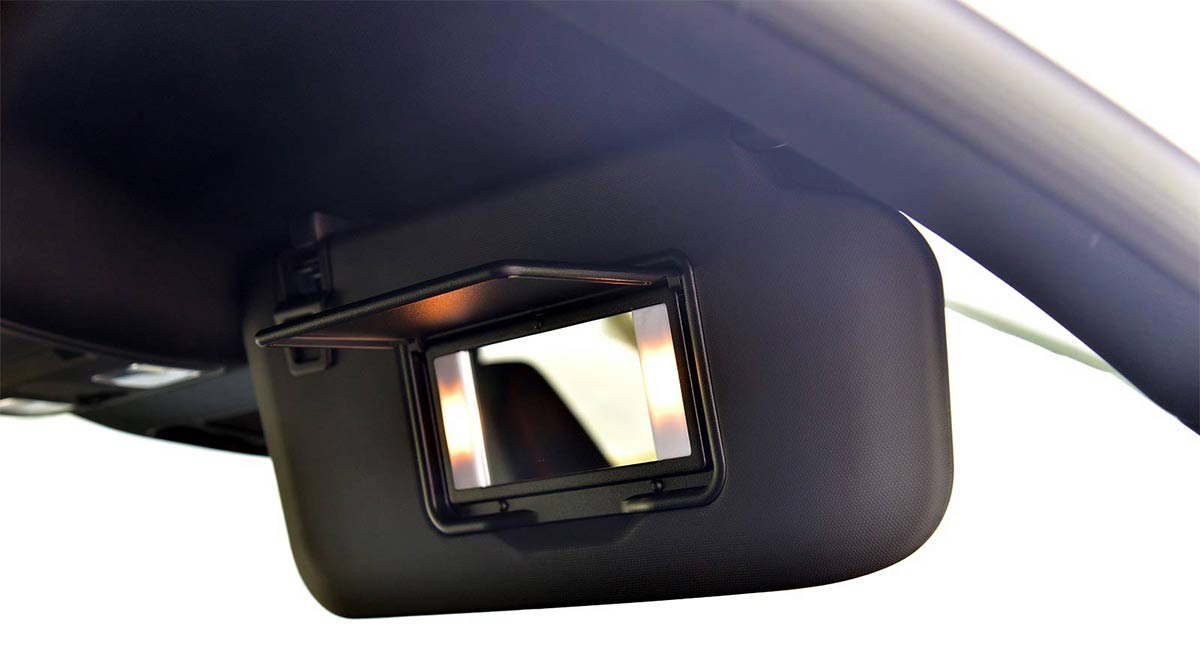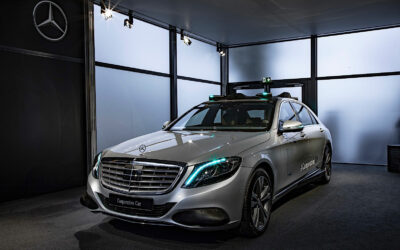Our report on Headliners and overhead systems covers a broad scope of overhead parts and functions, including sunvisors. Here, we zoom in on the visors.

Sunvisors are said to have been introduced on the 1924 model T Ford. Sunvisors, at least one of them on the driver’s side, soon came to be standard equipment in all cars. Many sunvisors have added-value features like mirrors, ticket holders, and extenders to allow coverage of the top of the view out the side window, or broaden the forward coverage wider than the visor. In the past, high-tech-of-the-day extra features included inbuilt programmable remote controls for electric garage door openers, and even cellular telephones built into sunvisors (video Crylsler).
The visor’s flap or core is typically a pressed or thermoformed part with a piece of metal for its attachment onto a mounting bracket. Some are made of molded substrates or PP. The mounting bracket is often a metal rod with a slight bend in the middle and a bracket that attaches it with screws to the sheet metal above the headliner. The bend in the rod serves to hold the visor flap in the desired position. The flap is covered with material, most often to match the interior of the vehicle. Padding on the sun visors became popular in the 1950s, at first as an option promoted as providing protection to passengers (who were virtually all unbelted and would surely be thrown forward in a crash or panic stop).
The visor plays a vital role to maintain safety while driving by protecting the driver from glare. NHTSA reports thousands sunglare-related car accidents each year, and another study indicates the risk of a car crash is 16 per cent higher during bright sunlight than under less-glaring conditions.

An LCD visor is an option, which does the normal things a visor does, and also integrates a display to extend information/entertainment to passengers.
The automotive sunvisor market grew from USD $1.46bn in 2023 to $1.59bn in 2024. Research and Markets predicts it will carry on growing at a CAGR of 9.50 per cent, reaching $2.77bn by 2030.
The market is segmented by component type—conventional or LCD, for example—material type (fabric, vinyl); features (mirror, light, compass, extended glare protection, etc), and vehicle type (passenger cars, commercial vehicles).
Glare Protection
Glare from the sun can be much more than annoying, it’s dangerous. On the windshield or the driver’s side window, sun glare can dazzle or blind occupants. The visor’s effectiveness against this is self-evident.
UV Protection
UVA rays penetrate the skin more deeply and are primarily responsible for premature aging and wrinkles. UVB rays are known to cause sunburn and are a significant contributor to skin cancer. Prolonged exposure to UV radiation, especially UVB, poses significant health risks, including skin cancer, cataracts, etc. And UV can also degrade auto interior materials.
Not much of the sun’s UV radiation gets through windshields, which block virtually all UVA and UVB. Side glass, however, is much less protective, blocking as little as 44 per cent of UV. It’s thought to be why skin cancer and cataract rates are elevated on the outboard side among people who drive (i.e., the left side in countries with RH traffic and LH-drive cars, and vice-versa).
Therefore, UV rays through car windows is a pertinent concern and sunvisors are an apt countermeasure. While the automotive sun visor industry is commonly associated with glare reduction and visibility improvement, its role in UV protection is equally important, contributing to the overall safety and health of drivers and passengers.
UV-blocking coatings, polarized visors, adjustability, and coverage help in enhancing UV protection through automotive sun visors. UV-blocking coatings on visors effectively reduce UV radiation penetration, shielding occupants from potential skin and eye damage.
Sunshades

Sunshades have a job related to that of the sunvisor, but they aren’t the same. A sunshade is meant for use when the car is parked. They are positioned on the windshield to prevent internal overheating and protect the vehicle’s interior components from sun damage.
Automation is possible; when the vehicle is parked, a motorized and/or automatic shade could be lowered to fully cover the windshield, keeping the interior cooler. Autoshades might also be made of transition-like material that can darken or lighten as necessary.
Automatic Sunvisors
Automatic visor systems use a sensor to detect the eye position of the driver or front passenger and the degree of light hitting their face. A motor deploys the visor into the best position by rotating it downward on a track hidden in the ceiling of the vehicle. Automatic visors can be more like sunglasses, in that they’re made of tinted, transparent material. They block sun without blocking the ability to see.
An automatic visor is especially effective when a setting or rising sun is entering the windshield just over the dash, or at an extremely low angle. It will also sense and block a dazzling blinding reflection off a bumper or rear window of a car that might be stopped ahead, either in a traffic jam or at a stop light.
Suppliers
In Europe, the most important supplier are Antolin and Daimay, a Chinese company which took over from Motus (Atlas Holdings), themselves having acquired the headliner and sun visor business of Johnson Controls. Other notable suppliers are: Gentex, Knauf, Kasai Kogyo, Martur Fompak, Irvin, Howa, Hayashi Telempu, along with an abundance of Chinese companies serving the aftermarket.
Antolin

Antolin has all the technologies adapted to each market to meet the most varied requirements for weight, safety, and customization.
Antolin has made several innovations in this product, such as SOR—Slide On Rod (lateral slide), retractable sunvisors, reduced thickness sunvisors, integration of multi-function mirrors, bio-materials, new design covers. They integrate lighting solutions that increase product functionality, from anti-glare halo lighting to custom backlit logos.
Bosch

Bosch’s innovative Virtual Visor (see DVN-I coverage and promotional video) uses a transparent LCD panel and ‘AI’ facial detection to block sun glare without obstructing the driver’s view. This improves driver safety and comfort by addressing the issue of temporary blindness caused by sun glare. It was presented at CES 2020, but not seen in any vehicle since.
In 2021, Bosch and Zeiss collaborated to integrate Zeiss’s expertise in optics and coatings with Bosch’s automotive technology. The partnership aimed to develop advanced sun visors with polarized lenses and UV-blocking coatings. These visors offer enhanced glare reduction and UV protection, improving driver visibility and passenger comfort.
Gentex

Gentex dimmable-glass technology uses electrochromic glass with what the supplier says is the greatest opacity range, the highest optical clarity, and the greatest durability in the market.
New to their product line are dimmable sunvisors. They fold down like a regular visor but include a clear panel that can variably darken as desired by the driver or passenger, thus cutting glare while still allowing forward vision. The darkening can be automatically or manually controlled.
Gentex and Toyota collaborated in 2022, and Gentex auto-dimming mirrors and smart glass technologies contributed to the development of Toyota sun visors with adjustable tint levels and integrated UV-blocking capabilities. These visors provide customizable coverage and UV protection, optimizing comfort and safety for vehicle occupants.
Daimay

Shanghai Daimay Automotive Interior Co., Ltd., mainly engaged in R & D, production and sales of passenger car components, is a professional auto parts supplier with integrated capabilities of design, development, manufacture, sales and service. Production part portfolio include sun visors, seats and headrests, steering wheels and roof consoles. Daimay holds a leading position in the global sun visor supply segment.
Daimay’s plant at Creutzwald, France (formerly JCI/Motus) produces 35,000 sunvisors per day.
Knauf Automotive

Knauf Group is a family-owned company based in Iphofen, Germany. They make sunvisors for cars and trucks, using high-quality expanded polypropylene (EPP). Their innovative double-action foam molding technique ensures precision and quality.
They focus on combining functional excellence with aesthetic appeal, offering sun visors with various surface structures to perfect the tactile and visual experience.
Martur Fompak

Martur Fompack, based in Istanbul, Turkey, makes seating systems, interior parts, and textiles. Their multi-technology approach enables products to integrate into the supply chains of customers on a global scale. Production technologies are sandwich, shell, EPP, or EPP & sandwich with manual sewing. They use high-frequency cutting, and different types of printing technologies such as digital printing, hot stamping, serigraph printing and pad printing (tampography).
Sustainability
Sunvisors, like all interior plastic-based components, will have to include progressively natural and recycled materials and sustainable practices in manufacturing to comply with regulations and to reduce environmental impact.






